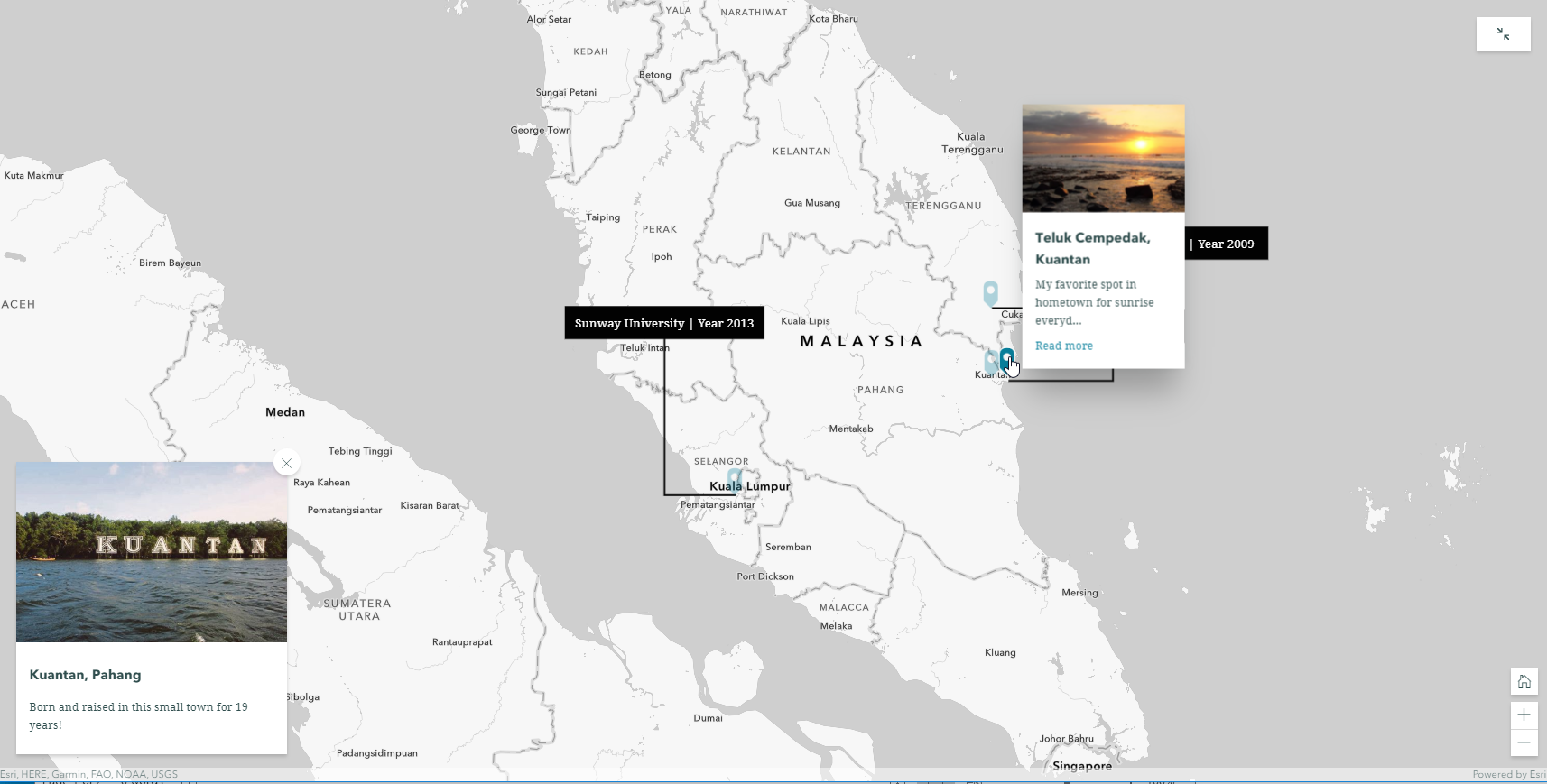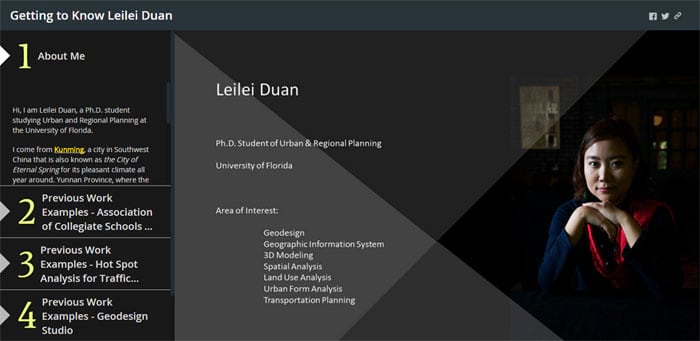- Home
- :
- All Communities
- :
- Industries
- :
- Education
- :
- Education Blog
- :
- Create a story map of your CV or resume!
Create a story map of your CV or resume!
- Subscribe to RSS Feed
- Mark as New
- Mark as Read
- Bookmark
- Subscribe
- Printer Friendly Page
- Report Inappropriate Content
Ever since they were created by my colleague Allen Carroll and his team, I have been an ardent supporter of story maps. I teach story map workshops regularly. I also give many presentations throughout the year, and in many of those, story maps are the means by which I give the presentations. One example is my presentation Geography: Key to Resiliency and a Healthy Planet, which was the keynote address I gave at a recent conference of the Geography Teachers Association of Victoria Australia. It has been amazing and heartwarming to see how they have been adopted by the GIS community and non-GIS community alike. Allen told me that by late 2019, over 1 million story maps had been created; they communicate in just about every conceivable field from archaeology to zoology!
Those of you reading this education blog know that here we are focused on education, and in the education space, story maps are used in many ways. Instructors use them to teach content (such as ocean currents, biodiversity, population change, and much more), and to teach skills in working with GIS tools, spatial data, and the ArcGIS platform. They are also useful in teaching about issues such as data quality, copyright (can I use that image in my map?), crowdsourcing, and to foster skills in communication. Students use story maps to document and showcase their work, to their peers, to their instructors, and as a living online resource that they can also show prospective employers. Students in my online courses regularly create story maps and send me the URL so that I can assess their work. In my face-to-face courses, students use them as a resource as they give oral presentations to myself and their peers instead of a standard PowerPoint, Microsoft Sway, or Prezi.
When I teach workshops focused on story mapping, I always say, "Make a story map of your CV or resume." Why? (1) It shows your prospective employer that you know something about web GIS tools; (2) It helps you to "stand out in the crowd". There is nothing wrong with a traditional text-based resume or CV, certainly, and I recommend that you provide a link to your story map CV on your traditional text-based CV. In fact I still lead with my text-based CV. (3) It is an interesting and engaging way to tell your story; (4) It provides a method for you to share your interactive maps, services, and multimedia (videos, audio, photographs) in a way that traditional methods do not allow; (5) It is a great way of encouraging yourself to keep current in story maps tools.
Since you know your own story best, it is an easy way to get started with story mapping, and it is something you can revisit quarterly or whenever you need to add to it; (6) It provides your colleagues and readers with encouragement that they could do this as well, thus spreading the geo-love. Indeed, as my colleague Bern Szukalski wrote in his essay "Things you didn't know you could do with story maps", CVs are listed along with newsletters, guides, tutorials, annual reports, promotions, engagements, and more as some of the things you can easily and powerfully do with story maps.
If you need some inspiration, here are some examples. Amanda Huber of Minnesota has probably received more attention than anyone about her story map, where she included examples of her own work and also sections on why GIS matters!
Part of Amanda Huber's story map.
An early but still compelling example here uses a Map Tour to feature "stops" along this person's journey. Kiara Dawson made sure she included her career objectives in her story map.
A 2019 Esri student volunteer, Jessica Liew, used the new express map function in the story maps tools for her story.

An effective use of the new express maps in this story.
The example below from Leilei Duan uses a Story Map Series with the side accordion layout, providing a compelling way for prospective employers to learn more about Leilei and also see her GIS work through interactive maps, including a very impressive CityEngine scene.


One of the best things about story maps and other web mapping applications from Esri is that they can be embedded in other types of multimedia. For example, Kate Berg hosted her content on GitHub and showcases two different styles of story maps, here.
Part of Kate Berg's story map, which is embedded into Kate's web page.
I'm not telling you all to do something I am not doing myself: My own Joseph Kerski story map CV, is here. I had a blast doing it and had to tear myself away after a few hours. I have the story map, a video about me, and my text-based CV linked to my website. In the map I included some 2D and 3D web maps associated with curricular items that I created, selected story map presentations (so, yes, a story map embedded in a story map!), and some of my favorite geeky photographs of myself, and some of my favorite landscapes and human-built ..., including the heaviest globe in the world, built in 1964 for the World's Fair, in New York City, below.
That is one big globe! It was created for the 1964 World's Fair.
But most importantly, my story map includes a web map with some of the accomplishments I wanted to feature. Why do I say most importantly? While you can certainly make a story map that is entirely composed of text and images and videos, the value-added component of story maps is .. maps! Thus I highly encourage you to include at least one interactive web map showing where you studied, traveled, had that internship and job, and so on.
What will I do with my CV story map next? My next task is to create a section that includes some of the people I have been most privileged to collaborate with. That will be fun and a kind way to acknowledge those who helped me along the way.
Part of my own storymap CV--Joseph Kerski.
Explore but don't feel confined to these examples: Be creative and do your own thing!
You must be a registered user to add a comment. If you've already registered, sign in. Otherwise, register and sign in.
-
Administration
38 -
Announcements
44 -
Career & Tech Ed
1 -
Curriculum-Learning Resources
178 -
Education Facilities
24 -
Events
47 -
GeoInquiries
1 -
Higher Education
518 -
Informal Education
265 -
Licensing Best Practices
46 -
National Geographic MapMaker
10 -
Pedagogy and Education Theory
187 -
Schools (K - 12)
282 -
Schools (K-12)
184 -
Spatial data
24 -
STEM
3 -
Students - Higher Education
231 -
Students - K-12 Schools
85 -
Success Stories
22 -
TeacherDesk
1 -
Tech Tips
83
- « Previous
- Next »

